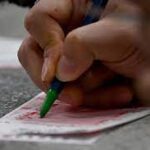Niche tours of hidden Tokyo reveal grit and history

I've always resisted the idea of taking a guided tour on my annual visits to Japan. My interests are pretty niche and I know Tokyo well enough that friends there have trouble suggesting new things to see.
This year I decided to try two guides offering personalized tours.
One, Lee Chapman , is a photographer who specializes in older neighborhoods. The other, Mark Hobold, writes a history blog called Japan This ! that is sometimes too geeky even for me.
Chapman says he takes guests to "an interesting, slightly grittier side of Tokyo that you never see in the media or guidebooks." This is clear from the start: Meeting in the touristy Asakusa neighborhood, we quickly leave the well-trodden areas for a block with street seating for a bar and eateries where people are already drinking and watching horse racing at 10 a.m. Sunday.
Chapman, an Englishman, has lived in Tokyo since 1998. Many of his photos show buildings in fascinating, beautiful states of decay — a fairly common sight despite Tokyo's image of futuristic newness. "I've realized from Instagram that a lot of people find that really interesting," he says. "But you won't see that in the Japanese media because they think it's a bad image."
He specializes in street shots of ordinary people, and ordinary life is what we see walking through these old residential neighborhoods. "It's where people live their lives. Especially in these areas, a lot of them have lived there their whole lives," he says. "There's a sense of community, with people talking with the shop owners and running into people on the street and chatting."
In fact they stopped to chat with Chapman, who's fluent in Japanese, more than once, like when we were contemplating a caged chicken outside a bar. A local explained it was there for good luck.
I could have learned a lot about photography from Chapman, but I was too distracted by his stories. Although when he took me to photograph an old restaurant that I'd particularly loved on his blog, that was a lesson about skilled professionals versus the rest of us. His photo was magical. Mine, despite repeated attempts, was a snapshot of an old building.
My tour with Hobold started at Nezu Shrine, a place I've visited dozens of times, but where I immediately learned new things. One was that a nondescript pile of stones was a monument for the burial of the afterbirth of the sixth shogun Tokugawa Ienobu, whose residence had been next to the shrine. "All the shoguns have these monuments," he said. Noted.
Hobold, an American who's lived in Japan since 2005, knows more Japanese history than even most Japanese care about. Once, for a meet-up with his "Japanese history nerd friends," his Japanese wife tagged along. "She left after 20 minutes bored to tears," he says.
So he knows that, as he says, "I have to grade my geekiness to the appropriate category." Customers find him via his blog, so they realize what they're getting into, but they have different backgrounds. "Some have a decent grasp of Japanese history. They have a context. Others have zero context," he says. For the latter, he says, he gives fewer names and dates and more stories, and makes familiar connections, like explaining to an American that something happened "around the time of the (U.S.) Civil War."
Why do people tour with him if they aren't that obsessed with samurai history? "Some are interested in history in general," he says. "If they go to another country they want to come away with an idea of the history. And they're genuinely curious people."
Photographers also book him: "They want Japanese-looking stuff that other people don't have."
Despite their differences, the tours had some similarities, like a focus on places that are gone: an old shoemaker's shop that Chapman once photographed, since torn down, or a long-vanished castle, now a park full of gnarled trees. Both tours also concentrated on areas that were not conventionally scenic.
Both guides also had a real depth of knowledge. Not tied to a canned, memorized spiel, we could spontaneously go off course if something caught my interest. At one point Hobold and I, drawn by the smell of a stand selling grilled octopus, headed to a temple that wasn't on the plan. After claiming he had nothing to say about it, he talked at some length about the legend of the resident goddess. He and a girlfriend had scoffed at the superstition that visiting the goddess' temples causes couples to split, but they broke up shortly after going to one.
Because they're so specialized, Chapman and Hobold also charge more than the more generic tours advertised on sites like Vayable and Airbnb's Experiences.
Both guides taught me ways of seeing the city that stuck with me. Hobold mentioned that a shrine in certain districts suggests there was once a samurai residence there. I remembered this later when I saw a small old shrine in upscale Omotesando that seemed out of place amid fashionable modern shops.
From Chapman's photography I've learned to peer, discreetly, past the showrooms of old-style stores to see the tatami-matted living areas behind, relics of a quickly vanishing city where life was once very different.
If You Go:
LEE CHAPMAN: https://leechapman.photos/tokyo-photowalk-tours/ . Tours $181-$316 for up to four people.
MARK HOBOLD: https://japanthis.com/japan-this-tours/ . Tours start at $450 for up to six people.
© Copyright 2018 The Associated Press. All rights reserved. This material may not be published, broadcast, rewritten or redistributed.
[contf] [contfnew] 
Japan Today
[contfnewc] [contfnewc]
















